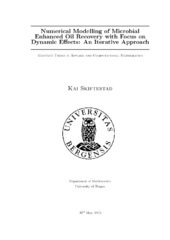Numerical Modelling of Microbial Enhanced Oil Recovery with Focus on Dynamic Effects: An Iterative Approach
Master thesis
Permanent lenke
https://hdl.handle.net/1956/10262Utgivelsesdato
2015-06-27Metadata
Vis full innførselSamlinger
Sammendrag
Recovering more of the available oil has been a main driver behind the extensive work done in the field of enhanced oil recovery (EOR) over the last decades. Microbial en- hanced oil recovery (MEOR) has been heavily researched, and is picking up pace com- pared with other EOR methods used today. MEOR is economically attractive and has a huge potential if applied in accordance to reservoir conditions. This thesis considers a two-phase flow regime in homogeneous porous media, under the influence of microbial activity. The mathematical model includes the concept of dynamic capillary pressure, and is based on Darcy's law, the principle of mass conservation and the diffusion/dispersion-advection equation. The inclusion of the dynamic capillary pressure makes this model classified as a so-called non-standard model. In this work we aim to explore this, as well as the effect microbes have on flow, and ultimately oil production. Implementation of the mathematical model has been done in MATLAB by using a new, fully implicit, iterative approach, to cope with the fact that the dynamic capillarity induces an additional temporal derivative in the two-phase model. The spatial dis- cretization has been carried out with the use of a control volume method, the TPFA, on a cell-centered grid in one dimension. The scheme is related to the papers [1-3]. The effects of dynamic capillary pressure are shown to be small at the macroscale for realistic oil reservoirs, while clearly visible in an extreme case which have been set up. Regarding microbial activity we have constructed relations between concentration and interfacial tension based on the work in [4-8]. This is done to model the effect of reduced fluid-fluid tension on flow and further the oil production. It is shown that a substantial concentration of microbes have a positive effect on the production, while small concentrations do not differ significantly from the case of no concentration.
